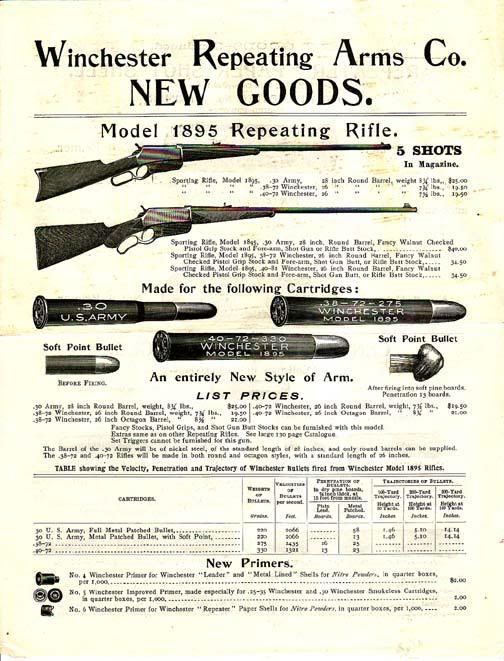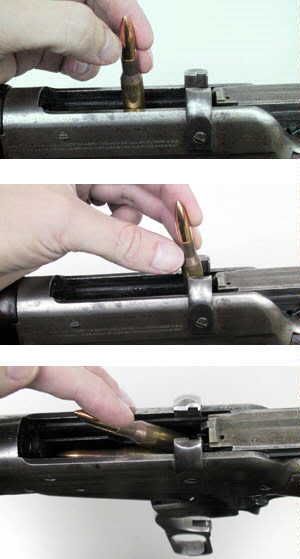
Once upon a time I was a 10 year old enthralled by firearms of all types and the history they helped to make. One day, somehow, my dad got a copy of Bill Riviere's paperback on shooting, "The Gunners Bible". In that book was a photo of a customized Winchester M1895 in .30-40. Oh, that gun was to die for. Give me some cold rainy day when I was forced inside and I'd stare a that photo for hours dreaming of hunts for moose, elk and big bears. So this was a gun I'd wanted for a long, long time when money in my pocket finally corresponded to the availability of a new gun, made by Miroku in Japan for Browning in 1985 and in .30-40Krag (.30 US) to boot! What a thrill!
 The Winchester 1895 was developed by John Browning for Winchester to load from a box magazine instead of a tube under the barrel. This allowed the Model 1895 to be chambered for military cartridges with spitzer (pointed) projectiles, and the rifle was used by the militaries of a number of nations including the US, Great Britain, and Imperial Russia. The Russian production models could also be loaded using charger clips, a feature not found on any other lever-action rifle. By far, the greatest numbers of the rifles were made for the Russian military. There were also produced in sporting rifle and saddle ring carbine versions. There were some famous users of the 1895 rifle of which the most well known would have been President Theodore Roosevelt. First, he carried one such rifle to Cuba which was chambered in .30 US. Later, both he and his son Kermit used the rifles chambered in .405 Winchester on his famous African safari. Ned Frost, a famous guide out of Cody, Wyoming, carried an 1895 SRC.
The Winchester 1895 was developed by John Browning for Winchester to load from a box magazine instead of a tube under the barrel. This allowed the Model 1895 to be chambered for military cartridges with spitzer (pointed) projectiles, and the rifle was used by the militaries of a number of nations including the US, Great Britain, and Imperial Russia. The Russian production models could also be loaded using charger clips, a feature not found on any other lever-action rifle. By far, the greatest numbers of the rifles were made for the Russian military. There were also produced in sporting rifle and saddle ring carbine versions. There were some famous users of the 1895 rifle of which the most well known would have been President Theodore Roosevelt. First, he carried one such rifle to Cuba which was chambered in .30 US. Later, both he and his son Kermit used the rifles chambered in .405 Winchester on his famous African safari. Ned Frost, a famous guide out of Cody, Wyoming, carried an 1895 SRC.  My rifle is as we'd expect for a Browning gun. Well made and well finished. She is just beautiful if a bit plain. With her 24" barrel, she's a bit longer than any other levergun in my safe. Yes, she has that distinctive (and advantageous) box magazine "hanging" below the receiver and some will balk at that as an impediment to comfortable carry. However, I find that the rifle balances right at the forward edge of the magazine and so it functions to provide the stop that keeps the rifle slipping through the hand and is in no way as uncomfortable for single handed carry as one might imagine it to be. When shooting the gun is every bit the lovely siren I imagined she might be.
My rifle is as we'd expect for a Browning gun. Well made and well finished. She is just beautiful if a bit plain. With her 24" barrel, she's a bit longer than any other levergun in my safe. Yes, she has that distinctive (and advantageous) box magazine "hanging" below the receiver and some will balk at that as an impediment to comfortable carry. However, I find that the rifle balances right at the forward edge of the magazine and so it functions to provide the stop that keeps the rifle slipping through the hand and is in no way as uncomfortable for single handed carry as one might imagine it to be. When shooting the gun is every bit the lovely siren I imagined she might be. The action is both smooth and tight with no rattling. Cartridges run through with little effort and, so far, no problems. Indeed, this action is about the smoothest of any of the famous Winchester levergun actions I've ever tried. Even new, it is slick and fast. Both round nose and spire point bullets are just the thing with neither providing problems of safety or in feeding. No problems in accuracy either! Groups of factory 180 SP ammo shoots into 2-3" at 100 yards with the issue open sights.
 I expect that it will do some better after I get a good aperture sight such as the Lyman 38 reproduction I bought. Just need to get the gun to Jon Ritenour in Harrisonburg to drill and tap it for the one screw necessary to mounting. This sight promises to be both more traditional and to provide a greater range of elevation adjustment. That elevation adjustment might just come in handy with the wide range of bullet weights usable in the .30-40 cartridge. Mine came from a private seller who got this Ukrainian sight from Buffalo Arms. These sights are imported from the Ukraine and may not be currently available except from buyers who've not yet installed their sights.
I expect that it will do some better after I get a good aperture sight such as the Lyman 38 reproduction I bought. Just need to get the gun to Jon Ritenour in Harrisonburg to drill and tap it for the one screw necessary to mounting. This sight promises to be both more traditional and to provide a greater range of elevation adjustment. That elevation adjustment might just come in handy with the wide range of bullet weights usable in the .30-40 cartridge. Mine came from a private seller who got this Ukrainian sight from Buffalo Arms. These sights are imported from the Ukraine and may not be currently available except from buyers who've not yet installed their sights.  Loading of the 1895 action is obviously not done the same way as the tube fed leverguns but it isn't quite the same as other box magazine guns either. There's a particular methodology used that ensures proper feeding of rimmed cartridges from the box magazine by ensuring the rim of each cartridge is ahead of the following cartridge.
Loading of the 1895 action is obviously not done the same way as the tube fed leverguns but it isn't quite the same as other box magazine guns either. There's a particular methodology used that ensures proper feeding of rimmed cartridges from the box magazine by ensuring the rim of each cartridge is ahead of the following cartridge. Ammunition? What about the .30 US (aka .30-40 Krag), is it effective? To what more popular cartridges does it compare? Is it hard to load? These are the questions I often hear.
In fact, the .30 US (aka .30-40 Krag) is extremely similar to the .303 British cartridge in both case form and in ballistic performance. So too, when loaded with bullets of the same weight, it is ballistically similar to the .300 Savage and .308 Winchester.
Of course, then, it is very effective on most North American game. I might prefer something bigger for the great bears such as the Grizzly and Polar bears but for everything else it will do nicely. The cartridge is no more difficult to handload than any other cartridge as there are no issues with the brass whatsoever. Powders suitable for similar sized cartridges as noted above will work in the .30 US as well. Bullets suitable for this cartridge and the 1895 action are also numerous and available. Standard primers are all that are needed to light the fire.

No comments:
Post a Comment
I only ask that you keep it clean and not spam readers. Thanks.